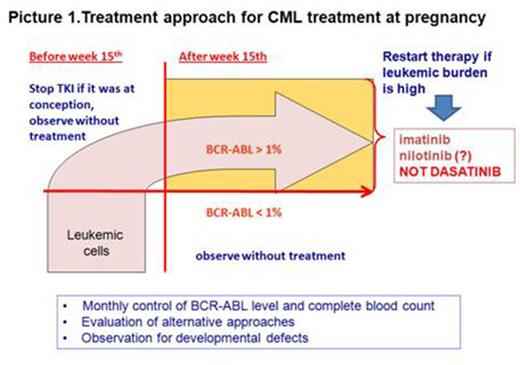Abstract

Background Using oftyrosine kinase inhibitors (TKIs) in women with chronic myeloid leukemia (CML) at pregnancy is risky due to possible teratogenecity. Absence of TKIs for whole pregnancy is risky for remission loss and disease progression. Particular situations may warrant TKI usage at pregnancy for potential benefits despite potential risks although no precise indications have been developed. Rareness of cases and ethical issues make significant difficulties in decision making.
Aim To develop and evaluate the treatment approach for CML and pregnancy considering leukemic burden and pregnancy terms.
Materials and methods During years 2011-2015 we monitored prospectively 29 cases of pregnancy in 28 women with CML chronic phase developing the treatment scheme step by step (picture 1).
In 16 cases molecular response (MR) at pregnancy start was the following: MR4 in 8 cases (BCR-ABL <0,01%), MR3 in 5 cases (BCR-ABL<0,1% and >0,01%), MR2 in 3 cases (BCR-ABL<1% and >0,01%). In 13 cases leukemic burden at pregnancy start was high: 6 cases without complete hematologic remission (CHR) including 5 newly diagnosed, 7 cases with BCR-ABL>1% and CHR. All women insisted to keep pregnancy in spite of risks. We recommended 1) immediate discontinuation of TKIs if they were taken 2) monthly follow-up of complete blood count (CBC) and BCR-ABL level by reverse quantitative polymerase chain reaction (RQ-PCR) 3) careful evaluation for developmental defects 4)possibility of using TKIs in cases of high leukemic burden starting from 15th pregnancy week as comparatively safe late term when main organogenesis is completed and blood-placental barrier (BPB) exists knowing that TKIs have limited BPB crossing ability.
High leukemic burden was considered BCR-ABL>1% as this level correlates with complete cytogenetic response (CCyR) absence and increased progression risk. The absence and/or loss of CHR was crucial to warrant TKIs. Alternative approaches including interferon, leukapheresis and staying without treatment were weighted in all cases. Dasatinib (DAS) was avoided due to multitargeted action, high fetal/maternal (F:M) concentrations and known possibility of hydrops fetalis. All patients were informed about possible risks at every stage of pregnancy.
Results
In 19 of 29 cases TKIs taken at conception were discontinued at 4th -10th week: imatinib (IM) in 17 and nilotinib (NIL) in 2. Evaluation for BCR-ABL level was done regularly but not monthly. Practically significant timepoints for BCR-ABL evaluation were pregnancy start, week 15th and pregnancy end. In 17 cases TKIs were reinitiated or started first: 4 newly diagnosed cases, 2 with CHR loss, 11 with BCR-ABL>1% (high level at pregnancy start or MR loss). The TKIs taken were IM in 14 cases (dose 400 mg), NIL in 3 (1-400 mg, 1-600 mg 1- 800mg). In 1 woman NIL was taken from week 10th due to CHR loss and resistance to IM.
In 12 other cases no TKIs were reinitiated at pregnancy as 11 had BCR-ABL<1% till pregnancy end and for 1 newly diagnosed at 35th week CML woman treatment was postponed till delivery.
In 24 cases TKIs were continued after delivery. Five women with MR3-MR4 at pregnancy end prolonged off-treatment period for breastfeeding being on regular PCR control. All 5 newly diagnosed women got an optimal response on IM. In 3 woman switch from IM to TKI2 was needed after delivery.
The 29 pregnancy outcomes were: 27 deliveries (1 woman twice), 1 spontaneous abortion on week 5th (IM stopped from week 4th), 1 non-developing pregnancy terminated at week 20th (IM at conception, intrauterine infection, normal fetus). All newborns had no birth defects. Eight children were born preterm (weeks 31-37), 7 of them had been exposed to TKIs after week 15th. Further development was without deviations, median follow-up 23 months (range 1 -52), including 17 children exposed to TKIs at late terms. In 5 cases the F:M concentration ratio was studied for IM and NIL ranging from 0,12 to 0,3.
Conclusion
Treatment approach considering leukemic burden and pregnancy terms may help to avoid treatment interventions in favorable situations and warrantinterests of both mother and child when treatment initiation is necessary.This approach can expand chances for woman with CML to have children. Possible risks should be understood by patient and physician. Management of CML at pregnancy in case of huge leukemic mass remains a complicated task, pregnancy in CML should be safely planned at deep remission.
Chelysheva:Bristol Myers Squibb: Honoraria; Novartis Pharma: Consultancy, Honoraria. Turkina:Bristol Myers Squibb: Consultancy; Pfizer: Consultancy; Novartis Pharma: Consultancy.
Author notes
Asterisk with author names denotes non-ASH members.

This icon denotes a clinically relevant abstract


This feature is available to Subscribers Only
Sign In or Create an Account Close Modal